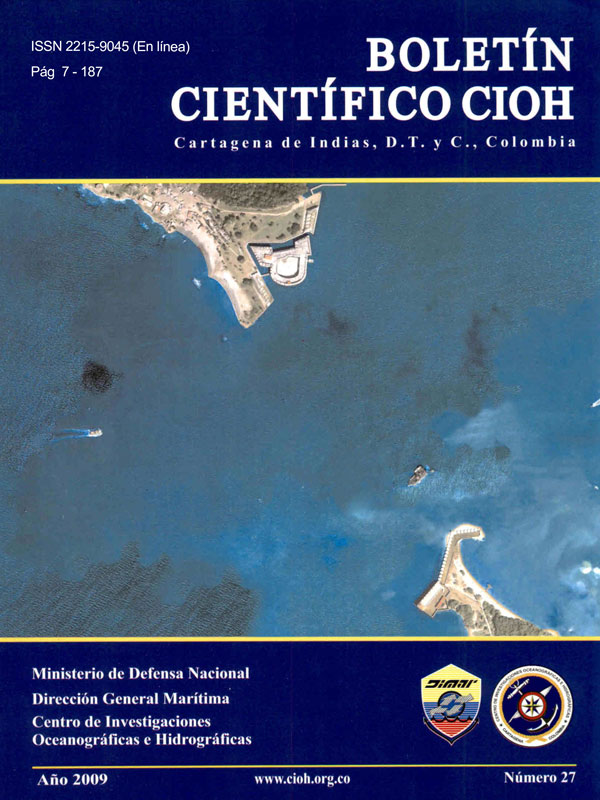Evolution of the Coast sand dune system of the Salamanca Island National Natural Park, the Magdalena River Eastern side, Colombian Caribbean
DOI:
https://doi.org/10.26640/22159045.209Keywords:
Sand dune, Salamanca Island National Natural Park, LiDAR, DTMs, GISAbstract
In this paper, results of the three-dimensional morphometric characterization and the evolution of the sand dune systems (in the Salamanca Island National Natural Park), East shore of Magdalena River (department of Magdalena) in the Colombian Caribbean. The analyses carried out included an estimate of the superficial changes of the dunes (4.24 m/year of falling behind rate) that had taken place between the years 2005 and 2008 based on the digital field information (DTMs) obtained with the LiDAR sensor, as well as an evaluation of the falling behind rate of the coastline based on aerial photographs from 1961 and the ortho-photospectrum from 2008 (5.70 m/year). Finally, an estimate of the sand volume corresponding to the active dunes in a specific sector from 2005 and 2008, and the volumetric balance, was quantified through a DTMs difference.Downloads
References
[2] Hellemaa, P. The Development of Coastal Dunes and their Vegetation in Finland. Doctoral dissertation, Department of Geography. University of Helsinki; 1998.
[3] Saye S, Van Der Wal D, Pye K, Blott S. Beach dune morphological relation ships and erosion/accretion: an investigation at five sites in England and Wales using LiDAR data. Geomorphology: 2006; 72: 128-155.
[4] Mitasova H, Overton M, Harmon R. Geospatial analysis of a coastal sand dune field evolution: Jockey's Ridge, North Carolina. Geomorphology: 2005; 72: 204-221.
[5] Stephenson W, Brander R. Coastal geomorphology into the twenty-first century. Progress in Physical Geography: 2003; 27, 4:607-623.
[6] Ojeda J, Vallejo I. El Empleo de los Modelos Digitales del Terreno (MDT) para la Caracterización Geomorfológica del Sistema de Dunas Móviles del Parque Nacional de Doñana (Huelva).In: Blanco-Chaoyotros, editor. Procesos geomorfológicos y evolución costera. Universidad de Santiago de Compostela. 2004. p. 119-132.
[7] Martínez J, Molina L. Geomorfología y aspectos erosivos del litoral Caribe, sector: Bocas de Ceniza-Parque Tayrona. INGEOMINAS Informe Inédito. Bogotá, Colombia. 1992.
[8] Carvajal A. Caracterización físico-biótica del litoral del departamento del Atlántico. En: DIMAR-CIOH. Caracterización físico-biótica del litoral Caribe colombiano. Tomo I. Serie Publicaciones Especiales CIOH Vol. 1. Cartagena de Indias, Colombia; 2009. Pp. 97-110.
[9] Marriaga L. Caracterización físico-biótica del litoral del departamento del Magdalena. En: DIMAR-CIOH. Caracterización físico-biótica del litoral Caribe colombiano. Tomo I. Serie Publicaciones Especiales CIOH Vol. 1. Cartagena de Indias, Colombia; 2009. Pp. 67-96.
[10] Ojeda J, Vallejo I, Hernández L, Álvarez J. Fotogrametría digital y LiDAR como fuentes de información en geomorfología litoral (marismas mareales y sistemas dunares): el potencial de su análisis espacial a través de SIG. Boletín de la A.G.E. 2007; 44: 215-233.
[11] White S, Wang Y. Utilizing DEMs derived from LiDAR data to analyze morphologic change in the North Carolina coastline. Remote Sensing of Environment: 2003; 85: 39-47.
[12] U.S. Geological Survey. Center for Coastal and Watershed Studies. National Assessment Of Shoreline Change: Part 1 Historical Shoreline Changes And Associated Coastal Land Loss Along The U.S. Gulf of Mexico. Open File Report 2004-1043; 2004.
[13] Woolard J, Colby J. Spatial characterization, resolution and volumetric change of coastal dunes using airborne LiDAR: Cape Hatteras, North Carolina. Geomorphology: 2002; 48: 269-287.
Downloads
Published
Issue
Section
License
Attribution — You must give appropriate credit, provide a link to the license, and indicate if changes were made. You may do so in any reasonable manner, but not in any way that suggests the licensor endorses you or your use.
NonCommercial — You may not use the material for commercial purposes.
NoDerivatives — If you remix, transform, or build upon the material, you may not distribute the modified material.
No additional restrictions — You may not apply legal terms or technological measures that legally restrict others from doing anything the license permits.



